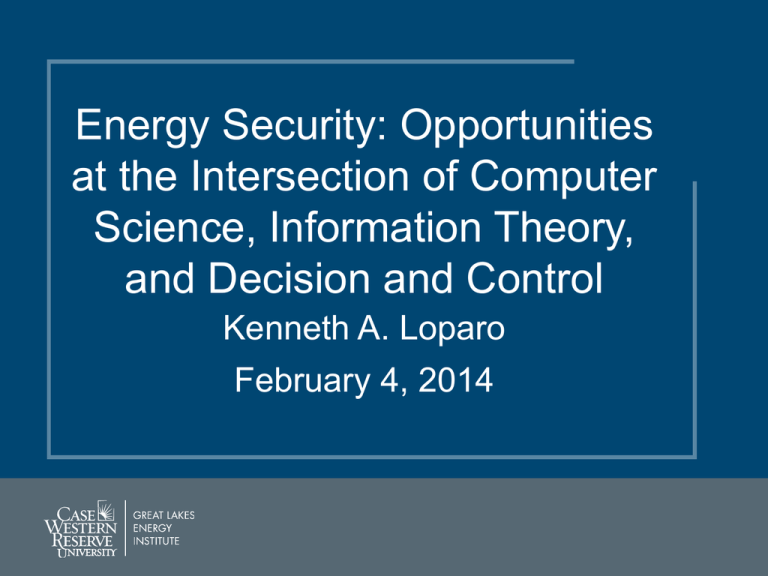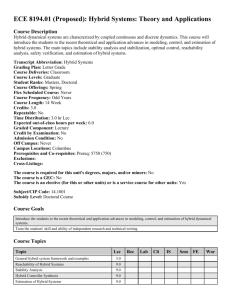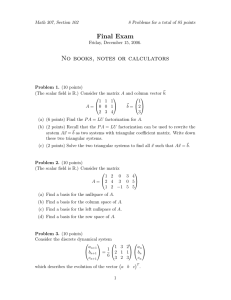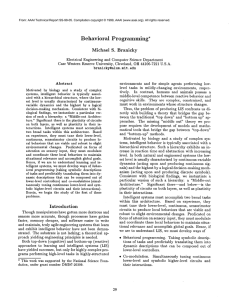Energy Security: Opportunities at the Intersection of Computer Science, Information Theory,
advertisement

Energy Security: Opportunities
at the Intersection of Computer
Science, Information Theory,
and Decision and Control
Kenneth A. Loparo
February 4, 2014
Energy Networks Highly interconnected, prone to cascade
effects
through state/structure interactions
Subject to many disturbances:
• Primary – Environmental, equipment
malfunctions, loads…
• Secondary – Protection mechanisms,
operator initiated controls, …
No global stability regimes, inter-area
behaviors
Seasonal, weather induced, and circadian
variations
Sensor poor => incomplete observability
Future Energy Systems: Improve command and
control through:
n Increased sensing and sensor fusion
n Command, communications and control
n Diagnose system operating state
n Manage a highly distributed and diverse
generation/load mix
n Improve operational readiness-predict
cascade effects
The Energy System is Complex
• Mul%-­‐level and Hierarchical • Dynamic System – Hybrid System-includes both continuous and
discrete variables
• Distributed System organized into modules/subsytems – Tightly and loosely connected subgroups
• Probabilis%c and stochas%c a=ributes (genera%on, demand, availability) • Mul%ple types of behaviors – Dynamics evolving on diverse temporal and spatial
scales
– Nonlinear with interactions between state and
structure
• Decision-­‐making at mul%ple levels – Coordination
– Control Energy System Opera%ng Model E=Equality Constraints
I=Inequality Constraints
Security is a time-varying
measure of the ability of
system to remain in the
Normal state.
Security Measure =
# p (x |Y )dx
"
t
S
S = set of secure states in the state space
p" (x |Yt ) = the conditional a posterior
density of the random hybrid dynamcial
system and " $ t
An Information-theoretic Architecture
for Situational Awareness
Operational Layer (SA, Health & Condition Monitoring, Decision & Control)
Decision Aids
x Information Manipulation
x Probing
x Sensitivity analysis
x Optimization
x Diagnosis/Prognosis
Query/Match
Archival Layer
Command & Control
x Operator commands
x Control law selection & tuning
x Policy objectives
x Scripting
Data Assimilation Layer (Extraction of useful information)
Information Archive
x Measures
x Metrics
x Features
x Patterns/Symmetry
Data Archive
x Raw data
x Time series data structure(s)
x Metatagging
User Interface
x Summary Variables
x Metrics
x Alarm/Alarm Mgmt.
x User representation
x Human factors
Data Structuring
x Correlation x Mutual information/
information rates
x System Structure
͞^ƵƌƉƌŝƐĞ͟
Information Mapping
x Data selection x Data fusion
x Data partitioning
x Clustering
x A priori knowledge
͞sĂůƵĞ͟
r(t)
Automation Layer
Characterization
x Model selection
x Statistical inference
x Feature extraction
x Representation hierarchy
x Measures
͞ŽƐƚ͟
Decode
v(t)
Data Collection Layer
Information Channels
ci
yi
Encode
0
y(t)
¢ ¢ ¢ cj ¢ ¢ ¢ ck ¢ ¢ ¢
¢ ¢ y¢j 0 ¢ ¢ ¢ y¢k 0¢ ¢
f(x; u; t)
Actuation Layer
u(t)
f 0 (x0 ; u0 ; t)
w(t)
u0 (t)
w0 (t)
u0 (t)
Random Dynamical Systems
• Stochas%c system-­‐ODE model: dx t = f (x t )dt
Initial value problem: x t = " t (x 0 ); x t = x 0 ~ p0 (x);t # t 0
0
Given the a priori density p0 (x) determine the a
posteriori density pt (x) !
! that f (x) is a smooth vector field :
Given
!n
"pt (x)
"
( f i (x) pt (x))
! = #$
"t
i=1 "x i
Stability must now be analyzed probabilistically, e.g,
almost sure stability:
Pr{lim x t = 0} = 1
t "#
Random Hybrid Dynamical Systems
• Dynamical Systems that include both con%nuous and discrete state elements, i.e. dx t = f "t (x t )dt
x t # R n , "t # {1,2,...,N}
Examples:
dx t = f "t (x t )dt
! Markov Process
"t is a FSCT
# xt &
% ( is a Markov Process
$ "t '
Joint density pt (x,i), i = 1,2,...,N
dxt = f!t (xt )dt
#% 1, x " A
t
R n = A ! B ! " AB , !t (x) = $
%& 2, xt " B
xt is a Markov Process
f! (x) is a discontinuous vector field
Hybrid Power System Model
Network
Topology
State-Structure
Interaction
Generator
Configuration
Hybrid Power System Model
Random Hybrid Dynamical Systems
• Because the vector field is discon%nuous, Liouville s Theorem is not applicable for determining the a posteriori density B
dx t = f "t (x t )dt
&1, x t % A
n
R = A # B # $AB , "t (x) = '
(2, x t % B
x
x t is a Markov Process
1
A
p!
t (x)
f " (x) is a discontinuous vector field
!
!
• We have developed a computa%onal !
! and method that solves this problem, "!AB
provides an approach to security evalua%on f 2 (x)
N
f1 (x)
pt2 (x)
Energy Security • Mathema%cal modeling of the power system-­‐stochas%c hybrid system with state/structure interac%on – State: Voltages, Angles – Structure: Network Topology • Security Evalua%on " pt (x |Yt )dx
– Es%ma%on Problem: S
min # p" (x |Yt )dx, " > t
• Security Assessment C
S
– Forecas%ng P!
roblem: max # p" (x |Yt )dx, " > t
• Security Enhancement u
S
– Stochas%c Control ! Problem: !
Future Distribution System
Desired System Capabilities
• Enable customer participation in electricity
markets
• Enable the integration of storage devices
• Enable distributed generation to enhance
grid stability/load serving capability
Distributed Architecture
• Device-level software agents:
– supply agents, load agents, storage agents,
network agents
• Agent connectivity through a real-time
communication network
– Adaptation of direct-level reactive controls
– Coordination to achieve system-level objectives
• System-level agents enable coordination and
functionality such as contingency analysis,
interchange scheduling, …








